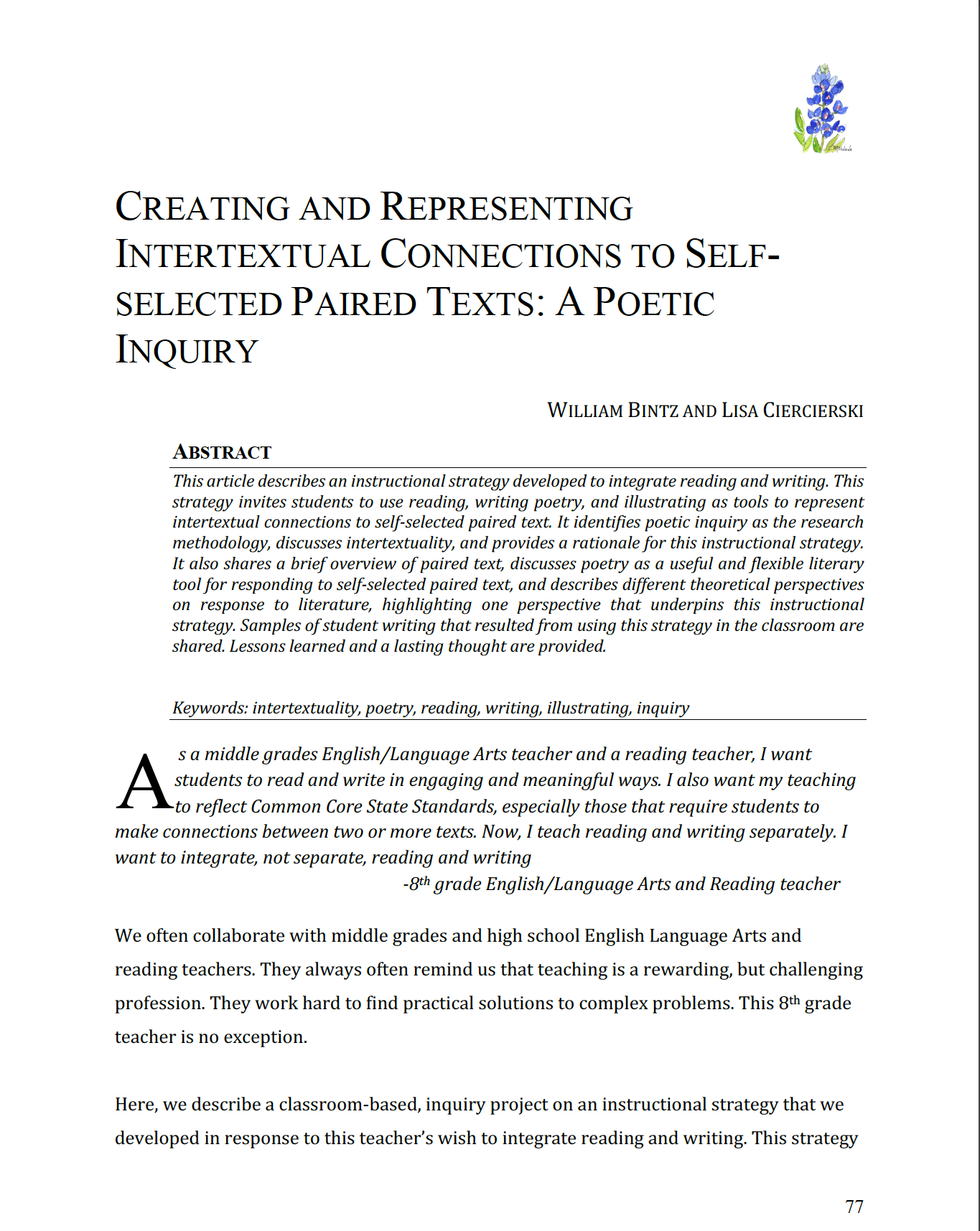Creating and Representing Intertextual Connections to Self-selected Paired Text
A Poetic Inquiry
Keywords:
poetry, intertexuality, reading, writing, illustrating, inquiryAbstract
This article describes an instructional strategy developed to integrate reading and writing. This
strategy invites students to use reading, writing poetry, and illustrating as tools to represent
intertextual connections to self-selected paired text. It identifies poetic inquiry as the research
methodology, discusses intertextuality, and provides a rationale for this instructional strategy. It
also shares a brief overview of paired text, discusses poetry as a useful and flexible literary tool
for responding to self-selected paired text, and describes different theoretical perspectives on
response to literature, highlighting one perspective that underpins this instructional strategy.
Samples of student writing that resulted from using this strategy in the classroom are shared.
Lessons learned and a lasting thought are provided.
References
Bahktin, M. (1986). The dialogic imagination: Four essays. Austin, TX: University of Texas Press.
Bateson, G. (2000). Steps to an ecology of mind: Collected Essays in anthropology, psychiatry, evolution, and epistemology. Chicago, Ill: University of Chicago Press.
Bloome, D., & Egan-Robertson, A. (1993). The Social Construction of Intertextuality in Classroom Reading and Writing Lessons, Reading Research Quarterly, 28(4), 304-333.
Brady, I. (2009). Introduction. In Prendergast, M., Leggo, C., & Sameshima, P. (Eds.) (2009). Poetic inquiry: Vibrant voices in the social sciences. Boston, MA: Sense Publishers, xi-xvi.
Butler-Kisber, L, & Stewart, M. The Use of Poetry Clusters in Poetic Inquiry. In Prendergast, M., Leggo, C., & Sameshima, P. (Eds.) (2009). Poetic inquiry: Vibrant voices in the social sciences. Boston, MA: Sense Publishers, 3-12.
Cahnmann-Taylor, M. (2003). The craft, practice, and possibility of poetry in educational research. Educational Researcher, 32(3), 29-36.
Eisner, E. (1997). The New Frontier in Qualitative Research Methodology, Qualitative Inquiry, 3(3), 259-273.
Eva-Wood, A.L. (2008). Does feeling come first? How poetry can help readers broaden their understanding of metacognition. Journal of Adolescent & Adult Literature, 51(7), 564-576.
Faulkner, S. L. (2009). Poetry as Method. New York: Routledge.
Galvin, K. T., & Prendergast, M. (Eds.) (2015). Poetic inquiry II - seeing, caring, understanding: Using poetry as and for inquiry. Boston, MA: Sense Publishers.
Harste, J., & Short, K., with Burke, C. (1988). Creating classrooms for authors. Portsmouth, NH: Heinemann.
Harvey, S., & Goudvis, A. (3rd Ed.) (2017). Strategies that work.
Harvey, S., & Goudvis, A. (2nd Ed.) (2007). Strategies that work. Portsmouth, NH: Heinemann.
James, K. (2017). What lovely words might also mean. In Sameshima, P., James, K, Leggo, C., & Fidyk, A. (Eds.). Poetic inquiry III. Wilmington, DE: Vernon Press.
Karolides, N.J. (1999). Theory and Practice: An Interview with Louise Rosenblatt. Language Arts, 77(2), 158-170.
Lewison, M., Leland, C., & Harste, J. (2014). Creating critical classrooms: Reading and writing with an edge. New York: Routledge.
Orr, L. (1986). Intertextuality and the cultural text in recent semiotics. College English, 48(8), 811-823.
Owlton, H. (2018). Doing poetic inquiry. United Kingdom: Palgrave Macmillan.
Prendergast, M. (2009). “Poem is what?” Poetic inquiry in qualitative social science research. International Review of Qualitative Research, 1(4), 541-568.
Prendergast, M., Leggo, C., & Sameshima, P. (Eds.) (2009). Poetic inquiry: Vibrant voices in the social sciences. Boston, MA: Sense Publishers.
Roen, D., & Karolides, N. (2005). Louise Rosenblatt: A Life in Literacy. The ALAN Review. Summer, 59-61.
Rosenblatt, L. (1995). Literature as exploration. New York: Appleton-Century.
Rosenblatt, L. (1988). Writing and reading: The transactional theory. In J. Mason (Ed.), Reading and Writing Connections. Newton, MA: Allyn and Bacon.
Short, K., & Harste, J., with Burke, C. (1996). Creating classrooms for authors and inquirers. Portsmouth, NH: Heinemann.
Smith, F. (1998). The book of learning and forgetting. New York: Teachers College Press.
Somers, A.B. (1999). Teaching poetry in high school. Urbana, Illinois: National Council of Teachers of English.
Texas Education Agency (1997). Texas essential knowledge and skills for kindergarten-grade
Austin, Texas.
Vincent, A. (2018). Is there a definition? Ruminating on poetic inquiry, strawberries, and the continued growth of the field. Art Research International: A Transdisciplinary Journal, 3(2), 48-76.
Literature Cited
Bing, C. (2001). The midnight ride of Paul Revere. Brooklyn, NY: Handprint Books.
Crew G. (2003). Troy Thompson’s excellent poetry book. La Jolla, CA: Kane/Miller.
Fleischman, P. (1988). Joyful Noise: Poems for two voices. New York: HarperCollins.
Fleischman, P. (1985). I am phoenix: Poems for two voices. New York: HarperCollins.
Granfield, L. (1995). In Flanders fields. Toronto, CA: Stoddart Kids.
Hall, M. (2015). Red: A crayon’s story. New York: Greenwillow Books.
Lendroth, S. (2005). Why explore? Berkeley, CA: Tricycle Press.
Lewis, (2012). Edgar Allan Poe’s Pie: Math Puzzlers in Classic Poems. Boston, MA: Harcourt
Children’s Books.
Lewis, J. P. (2009). The house. Mankato, MN: Creative Editions.
Lewis, J.P. (1998). Doodle dandies: Poems that take shape. New York: Atheneum Books.
Lewis, J.P. (2002). A world of wonders. New York: Dial Books for Young Readers.
Lewis, J.P., & Janeczko, P.B. (2008). Birds on a wire. Honesdale, PA: Wordsong.
Mannis, (2002). One Leaf Rides the Wind. New York: Viking.
Nelson, M. (2009). A wreath for Emmett Till. Orlando, FL: HMH Books for Young Readers.
Pappas, T. (1991). Math talk: Mathematical ideas in poems for two voices. San Carlos, CA:
Wide World Publishing/Tetra.
Rosenstock, B. (2014). The noisy paint box: The colors and sounds of Kandinsky’s abstract art. New York: Knopf Books for Young Readers.
Scieszka, J. (2004). Science verse. New York: Viking Books for Young Readers.
Schnur, S. (2001). Summer: An alphabet acrostic. New York: Clarion Books.
Sidman, J. (2016). Before morning. Orlando, FL: HMH Books for Young Readers.
Vergo, F. (2012). Sciencepalooza: A collection of science poetry for primary and intermediate
students. Bloomington, IN: AuthorHouse.
Whitman, W., & Long, L. (2004). When I heard the learn’d astronomer. New York: Simon &
Schuster Books for Young Readers.
Young, J. (2010). R is for rhyme: A poetry alphabet. Ann Arbor, MI: Sleeping Bear Press.

Downloads
Published
Issue
Section
License
All copyright remains with the author.

